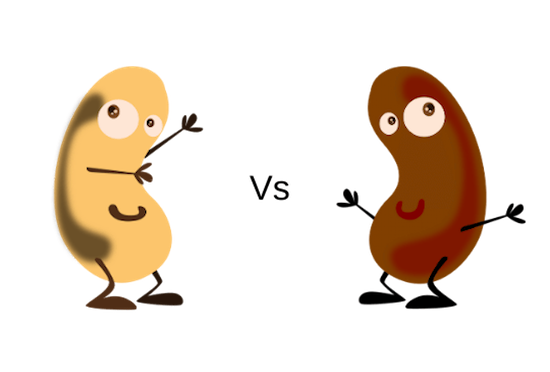
Picture it: You’re moving up in line at your favorite Mexican takeout place, thinking about all the delicious ingredients you’re going to order to make your bowl. Today, you’re thinking beans sound great for your primary protein — but which one should you choose? Both options are yummy, but are black beans or pinto beans healthier?
Let’s do a comparison of everything you need to know about pinto vs black beans, so you can make more informed decisions when enjoying these tasty legumes.
What’s the Difference Between Pinto vs Black Beans?
Both pinto and black beans are nutrient-dense, flavorful, and enjoyed around the world in a variety of cuisines, like Mexican, South and Central American, Cajun, and Creole Caribbean — but they do have some unique characteristics. Black beans come from South America, while pinto beans originate from Mexico and the southwestern United States.
As for their appearance, pinto beans are tan or beige with darker brown speckles and turn more of a reddish-brown when they’re cooked. Black beans have a black, shinier exterior and are slightly smaller in size. Taste-wise, pinto beans are softer with a mild, earthy flavor whereas black beans are a little denser with a meatier texture and slightly sweeter flavor.
Next, we’re taking a look at the nutritional and health differences between the two, plus some delicious ways to use them in meals.
Black Beans vs Pinto Beans Nutrition
Legumes are some of the healthiest plant foods on the planet, and you really can’t go wrong when choosing between beans. However, there are some nutritional differences between black beans vs pinto beans that may be important for you to consider. Here are the highlights.
A one-cup (172-gram) serving of cooked black beans without added salt has the following nutritional makeup:
- Calories: 227
- Protein: 15 grams
- Fat: 1 gram
- Total Carbs: 41 grams
- Fiber: 15 grams
- Calcium: 46 mg
- Iron: 4 mg
- Magnesium: 120 mg
- Potassium: 611 mg
- Folate: 256 mcg
In one cup (171 grams) of cooked pinto beans without added salt, you’ll get these nutrients:
- Calories: 245
- Protein: 15 grams
- Fat: 1 gram
- Total Carbs: 45 grams
- Fiber: 15 grams
- Calcium: 79 mg
- Iron: 3.5 mg
- Magnesium: 85 mg
- Potassium: 745 mg
- Folate: 294 mcg
Overall, pinto beans provide slightly more calories, calcium, folate, and potassium per serving, whereas black beans are higher per serving in magnesium and iron. Both varieties of beans are similar in terms of calories, protein, fat, carbs, and fiber.
Health Benefits
Both black and pinto beans are incredibly healthy additions to your diet. Here are some of the ways they contribute to your overall wellness.
General Health Benefits of Beans
- Heart Health: Beans are a good source of soluble fiber, which helps lower high cholesterol levels and reduce your risk of heart disease. They also provide around 15% of the Daily Value per cup for potassium, a mineral that counteracts the effects of sodium in raising blood pressure.
- Digestive Health: The high fiber content of beans helps support a healthy gut microbiome, the community of microbes living in your digestive system. They also help prevent constipation and promote healthy digestion.
- Blood Sugar Regulation: Beans are considered a low glycemic index food, which means they don’t raise your blood sugar quickly, preventing dramatic spikes and falls. This is good for everyone but especially important for individuals living with diabetes.
- Cancer Prevention: Beans provide important compounds like antioxidants and phytochemicals, which may have cancer-protective properties.
- Weight Management: Beans are high in fiber and protein and low in fat. These nutrients help you feel fuller for longer after eating, which can prevent overeating and support weight management goals. One study found that women who ate moderate or high amounts of beans in their diet pattern also had lower body fat and smaller waist circumference compared to women who didn’t eat many beans. The authors found that for each 10% increase in bean intake (measured in cups of beans per 1000 calories), body fat tends to be 12% lower.
Black vs Pinto Beans: Specific Benefits and Differences
When comparing black vs pinto beans, there are a few unique health benefits between them:
Black Beans: Black beans are particularly high in antioxidants (like anthocyanins) which are compounds that help protect your cells from stress and damage that can promote chronic disease. They’re also higher in magnesium per serving, which is an important mineral for supporting your sleep, blood sugar regulation, mood, and exercise performance.
PInto Beans: PInto beans are especially good for your heart because of their higher folate content. Folate is a B vitamin that helps reduce levels of homocysteine, an amino acid that increases your risk of heart disease when elevated. Pinto beans also contain a bit more potassium per serving, which is important for blood pressure control and fluid balance.
Best Uses
Beans are super versatile in the kitchen, and you can purchase them canned or dried (which you then soak before cooking). If you’re not used to regularly cooking with them or need some new ideas, below are some ways you can start adding them to meals. Note that black and pinto beans can be used in similar ways and it ultimately comes down to personal preference.
Try adding black and pinto beans to healthy meals in these ways:
- Burritos
- Tacos
- Black Bean Soup
- Mixed Green Salads
- Mango or Tomato Salsas
- Bean Dips
- Rice and Bean Dishes
- Veggie Burger Patties
- Chili
- Quesadillas
- Enchiladas
- Pasta Dishes
Are Black Beans or Pinto Beans Healthier?
When it comes to comparing healthy foods to healthy foods — like pinto vs black beans — it’s hard to declare a clear winner. If you don’t regularly eat beans, I’d encourage you to try them both! There are small differences in nutrition, appearance, and flavor between the two, which uniquely complement your diet and your recipes.
References
- USDA FoodData Central. (2019). Beans, black, mature seeds, cooked, boiled, without salt. Retrieved from: https://fdc.nal.usda.gov/fdc-app.html#/food-details/173735/nutrients
- USDA FoodData Central. (2019). Beans, pinto, mature seeds, cooked, boiled, without salt. Retrieved from: https://fdc.nal.usda.gov/fdc-app.html#/food-details/175200/nutrients
- Nchanji EB, Ageyo OC. Do Common Beans (Phaseolus vulgaris L.) Promote Good Health in Humans? A Systematic Review and Meta-Analysis of Clinical and Randomized Controlled Trials. Nutrients. 2021;13(11):3701. Published 2021 Oct 21. doi:10.3390/nu13113701
- Soliman GA. Dietary Fiber, Atherosclerosis, and Cardiovascular Disease. Nutrients. 2019;11(5):1155. Published 2019 May 23. doi:10.3390/nu11051155
- Makki K, Deehan EC, Walter J, Bäckhed F. The Impact of Dietary Fiber on Gut Microbiota in Host Health and Disease. Cell Host Microbe. 2018;23(6):705-715. doi:10.1016/j.chom.2018.05.012
- Mullins AP, Arjmandi BH. Health Benefits of Plant-Based Nutrition: Focus on Beans in Cardiometabolic Diseases. Nutrients. 2021;13(2):519. Published 2021 Feb 5. doi:10.3390/nu13020519
- Campos-Vega R, Oomah BD, Loarca-Piña G, Vergara-Castañeda HA. Common Beans and Their Non-Digestible Fraction: Cancer Inhibitory Activity-An Overview. Foods. 2013;2(3):374-392. Published 2013 Aug 2. doi:10.3390/foods2030374
- Tucker LA. Bean Consumption Accounts for Differences in Body Fat and Waist Circumference: A Cross-Sectional Study of 246 Women. J Nutr Metab. 2020;2020:9140907. Published 2020 Jun 6. doi:10.1155/2020/9140907
